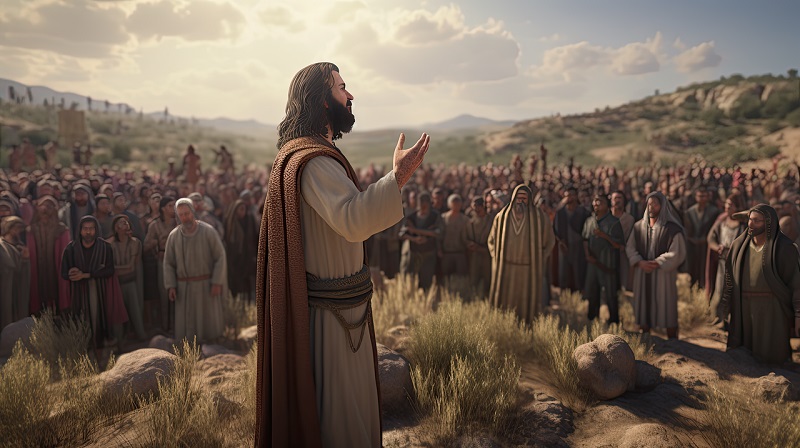Imagine a world where disagreements lead to healing rather than division — this ideal is not just a dream, but a reality depicted in numerous examples of reconciliation in the Bible.
The Bible offers timeless wisdom that addresses the complexities of human relationships, reminding us of the importance of mending fences and seeking peace.
By delving into these examples, this article aims to equip you with insights that are as relevant now as they were thousands of years ago.
✅ The 7 Examples of Reconciliation in the Bible

By studying biblical examples of reconciliation, believers can understand how humility, repentance, and faith lead to healing and strengthened connections.
1. Joseph Reconciles with His Brothers
In Genesis 45, Joseph’s act of forgiveness offers one of the most striking examples of reconciliation in the Bible.
When his brothers arrived, driven by desperation due to a severe famine, they were confronted with the very brother they had wronged.
Rather than lashing out or exacting revenge, Joseph displayed an astounding level of grace, revealing not only his power but also his profound understanding of their shared history.
He recognized that their betrayal, while painful, was part of a divine plan that ultimately led to his rise and their salvation.
Joseph’s response invites you to reflect on your own relationships.
The courage to forgive and extend compassion, even to those who have caused deep hurt, can transform narratives of pain into stories of healing.
This moment emphasizes that true reconciliation requires vulnerability and humility, showing that forgiveness is a deliberate choice that fosters love over bitterness.
By embracing his brothers, Joseph illustrated that reconciliation is not merely about restoring a relationship — it’s about understanding the broader context of one’s experiences and choosing to heal together, a theme that resonates throughout biblical examples of reconciliation.
2. Esau and Jacob Reconciliation
The reunion of Jacob and Esau stands as a powerful narrative in the tapestry of biblical reconciliation, demonstrating that healing can arise even from the deepest rifts.
Their story underscores that reconciliation often begins with humility.
Jacob approached Esau with reverence, bowing seven times, symbolizing his recognition of past wrongs.
This act of humility was not merely a gesture; it was an invitation for dialogue and understanding, setting the tone for their encounter.
Esau’s warm embrace signifies the transformative power of forgiveness.
Rather than meeting Jacob with resentment, he chose compassion, illustrating that true reconciliation requires a willingness to move beyond past grievances.
This dynamic exchange invites readers to reflect on their own relationships, encouraging the notion that embracing vulnerability can lead to profound healing.
Just as with other examples of reconciliation in the Bible, such as that between Joseph and his brothers, this moment serves as a reminder that family bonds, once fractured, can be mended through love and grace.
3. David and Saul
David’s patient response to King Saul’s relentless pursuit is a profound testament to his character and an inspiring narrative from the stories of reconciliation in the Bible.
In multiple confrontations, including the intense moments within the cave of En Gedi, David refrained from retaliating, even when given the chance to eliminate his enemy.
Instead of letting anger dictate his actions, he recognized Saul as the Lord’s anointed, demonstrating a deep respect for the divine order and an understanding of mercy’s transformative power.
This choice not only preserved his integrity but also highlighted the often-overlooked strength in restraint.
David’s decision to spare Saul serves as a poignant reminder that reconciliation often begins with one party choosing compassion over vengeance.
His mercy opened the door for moments of reflection and potential healing between them, emphasizing that true leadership is rooted in forgiveness and understanding.
In an age where conflict and division reign, these narratives from David’s life underscore the critical importance of patience, suggesting that when we choose grace over grievance, we sow the seeds for peace — even in the most hostile relationships.
David’s journey illustrates that the path to unity often lies in the deliberate act of choosing to forgive, setting a powerful example for future generations.
4. Israelites and God After Idolatry
Through the lens of the Israelites’ relationship with God, we see a compelling narrative of human frailty and divine mercy.
Despite their recurrent slips into idolatry, each moment of turning back became a catalyst for profound restoration.
Stories of reconciliation in the Bible vividly illustrate that God is not just a distant judge but a compassionate Father who eagerly awaits His children’s return.
The call for confession and humility is not merely a requirement; it’s an invitation to deeper intimacy with the divine.
Consider the significance of 2 Chronicles 7:14 — it’s a heart-cry for transformation that transcends time.
When the Israelites repented, they weren’t just seeking to escape judgment; they engaged in a radical reshaping of their identities, choosing to acknowledge their wrongs and redirect their paths towards God’s ways.
This transformative act highlights a core principle: true reconciliation is born from the ashes of repentance, where vulnerability opens avenues for grace and renewal.
Each story of the Israelites serves as a reminder that no matter how far we stray, the path back to God remains accessible for those willing to humble themselves and seek His face.
5. The Prodigal Son
The parable of the Prodigal Son offers a profound glimpse into the theme of reconciliation, not just between a father and son, but as a reflection of divine love.
The father’s immediate acceptance of his wayward son highlights the transformative power of forgiveness.
When the son recognizes his mistakes, his return is laden with humility, representing a crucial step in many biblical examples of reconciliation.
It prompts us to consider the importance of acknowledgment and remorse in mending broken relationships.
The elder brother’s reaction adds a layer of complexity to the story.
His resentment towards his father’s lavish welcome challenges us to reflect on our own attitudes towards forgiveness and grace.
Are we sometimes reluctant to celebrate the restoration of others due to our sense of injustice?
Through this narrative, we are pushed to examine our own hearts, leaning into the call to not only accept reconciliation but also to actively participate in the redemptive process, echoing other biblical tales where grace prevails over pride.
Ultimately, the Prodigal Son reminds us that it’s never too late to seek restoration, and that love can bridge even the widest divides.
6. Peter’s Restoration by Jesus
In the wake of Peter’s denial, his reinstatement by Jesus serves as a profound example of reconciliation in the Bible.
This pivotal moment not only showcases Jesus’ boundless forgiveness but also emphasizes the importance of personal accountability and growth.
By asking Peter three times, “Do you love me?”, Jesus invites him to confront his past failures and reestablish their relationship, demonstrating that true restoration often requires grappling with our shortcomings.
This encounter reflects the transformative power of grace; it’s a reminder that our personal failures do not define us.
Just as Peter was given a chance to redeem himself, we, too, can find healing through our brokenness.
The narrative inspires us to embrace forgiveness in our own lives, understanding that reconciliation extends beyond mere words — it’s an action that paves the way for renewal.
Peter’s journey from denial to leadership also encourages us to recognize that even the most fractured relationships can be mended through compassion, humility, and a genuine desire to restore the bond.
7. Paul and the Corinthian Church
In the tumultuous life of the Corinthian church, Paul’s approach to addressing divisions provides a profound example of reconciliation in the Bible.
He understood that the tensions within the community stemmed not just from individual sins, but from a deeper spiritual disconnection.
Through candid communication and a heartfelt appeal for accountability, Paul crafted a pathway for healing.
He emphasized the need for the congregation to forgive a member who had strayed, illustrating that restoration hinges not only on repentance but also on the willingness to be vulnerable and open-eyed about injustices.
This model of reconciliation resonates beyond Corinth, echoing the narratives of other biblical figures who faced conflicts.
Just as Joseph reconciled with his brothers despite their betrayal, Paul advocated for a community built on love and forgiveness, reminding the Corinthians of their shared identity in Christ.
Ultimately, Paul’s guidance highlights a vital truth: reconciliation, guided by God’s wisdom, is a transformative process that not only restores relationships but also fortifies the entire community against future divisions.
By responding to conflict with grace and accountability, the Corinthian church moved toward unity, exemplifying the power of collective healing in the face of sin.
Examples of Reconciliation in the Bible (Summary)
Examples of reconciliation in the Bible provide timeless lessons on forgiveness, restoration, and God’s mercy.
Joseph’s forgiveness of his brothers, the reconciliation of Esau and Jacob, David’s restraint toward Saul, and the Israelites’ returning to God after idolatry all demonstrate that reconciliation requires humility, repentance, and trust in divine guidance.
In the New Testament, stories such as the Prodigal Son, Peter’s restoration by Jesus, and Paul’s reconciling with the Corinthian church show that reconciliation is possible even after significant failures and conflicts.
These biblical examples inspire believers to seek forgiveness, restore broken relationships, and embrace God’s mercy in every aspect of life.
Applying these lessons today encourages individuals to act with compassion, patience, and faith, fostering unity and spiritual growth.
Ultimately, reconciliation is not just about restoring relationships with others but also about deepening one’s relationship with God, reflecting His love, and demonstrating His transformative power in daily life.
Frequently Asked Questions (FAQs) About Reconciliation in the Bible
1. What are some examples of reconciliation in the Bible?
Examples include Joseph forgiving his brothers, Esau and Jacob reconciling, David sparing Saul, the Israelites returning to God, the Prodigal Son, Peter restored by Jesus, and Paul reconciling with the Corinthian church.
2. Why is reconciliation important in the Bible?
Reconciliation emphasizes forgiveness, restored relationships, unity, and spiritual growth. It demonstrates God’s mercy and encourages believers to maintain peace with others and God.
3. How can we apply biblical lessons of reconciliation today?
We can apply these lessons by forgiving others, seeking restoration in broken relationships, approaching conflicts with humility, and trusting God’s guidance in the process.
4. Can reconciliation restore broken relationships completely?
Yes, biblical examples show that with humility, repentance, and effort, reconciliation can fully restore trust, unity, and spiritual bonds.
5. Does reconciliation only involve humans, or does it include God?
Reconciliation includes both relationships with others and with God. Biblical examples emphasize restoring bonds with God through repentance, faith, and returning to His ways.
Other Blog Posts
- 7 Examples of Reaping What You Sow in the Bible
- 6 Examples of Quiet Time in the Bible
- 6 Examples of Quarantine in the Bible

Grounded in faith and driven by purpose, I’m a Christian blogger and online research specialist with a passion for God’s Word, lifelong learning, and healthy living.
